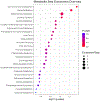A metabolome and microbiome wide association study of healthy eating index points to the mechanisms linking dietary pattern and metabolic status
- PMID: 34057579
- PMCID: PMC8572162
- DOI: 10.1007/s00394-021-02599-9
A metabolome and microbiome wide association study of healthy eating index points to the mechanisms linking dietary pattern and metabolic status
Abstract
Background: Healthy eating index (HEI), a measure of diet quality, associates with metabolic health outcomes; however, the molecular basis is unclear. We conducted a multi-omic study to examine whether HEI associates with the circulatory and gut metabolome and investigated the gut microbiome-HEI interaction on circulating and gut metabolites.
Methods: Through a cross-sectional study, we evaluated diet quality in healthy individuals [the ABO Glycoproteomics in Platelets and Endothelial Cells (ABO) Study, n = 73], metabolites (measured at Metabolon Inc.) in plasma (n = 800) and gut (n = 767) and the gut microbiome at enterotype and microbial taxa (n = 296) levels. Pathway analysis was conducted using Metaboanalyst 4.0. We performed multi-variable linear regression to explore both the HEI-metabolites and HEI-microbiome associations and how metabolites were affected by the HEI-microbiome interaction. In the Fish oils and Adipose Inflammation Reduction (FAIR) Study (n = 25), analyses on HEI and plasma metabolites were replicated. Estimates of findings from both studies were pooled in random-effects meta-analysis.
Results: The HEI-2015 was associated with 74 plasma and 73 gut metabolites (mostly lipids) and with 47 metabolites in the meta-analysis of the ABO and FAIR Studies. Compared to Enterotype-1 participants, those with Enterotype-2 had higher diet quality (p = 0.01). We also identified 9 microbial genera associated with HEI, and 35 plasma and 40 gut metabolites linked to the HEI-gut microbiome interaction. Pathways involved in the metabolism of polar lipids, amino acids and caffeine strongly associated with diet quality. However, the HEI-microbiome interaction not only influenced the pathways involved in the metabolism of branch-chain amino acids, it also affected upstream pathways including nucleotide metabolism and amino acids biosynthesis.
Conclusions: Our multi-omic analysis demonstrated that changes in metabolism, measured by either circulatory/gut metabolites or metabolic pathways, are influenced by not only diet quality but also gut microbiome alterations shaped by the quality of diet consumed. Future work is needed to explore the causality in the interplay between HEI and gut-microbiome composition in metabolism.
Keywords: Diet quality; Healthy eating index; Metabolic pathway; Metabolome; Microbiome; Multi-omic study.
© 2021. Springer-Verlag GmbH Germany, part of Springer Nature.
Conflict of interest statement
The authors have no conflicts of interest to disclose.
Figures



Similar articles
-
Multi-Omic Analysis of the Microbiome and Metabolome in Healthy Subjects Reveals Microbiome-Dependent Relationships Between Diet and Metabolites.Front Genet. 2019 May 17;10:454. doi: 10.3389/fgene.2019.00454. eCollection 2019. Front Genet. 2019. PMID: 31164901 Free PMC article.
-
Workplace food purchases, dietary intake, and gut microbial metabolites in a secondary analysis of the ChooseWell 365 study.Am J Clin Nutr. 2024 Jun;119(6):1504-1513. doi: 10.1016/j.ajcnut.2024.04.022. Epub 2024 Apr 25. Am J Clin Nutr. 2024. PMID: 38677520 Free PMC article. Clinical Trial.
-
A meta-analysis study of the robustness and universality of gut microbiome-metabolome associations.Microbiome. 2021 Oct 12;9(1):203. doi: 10.1186/s40168-021-01149-z. Microbiome. 2021. PMID: 34641974 Free PMC article.
-
Dietary glycation compounds - implications for human health.Crit Rev Toxicol. 2024 Sep;54(8):485-617. doi: 10.1080/10408444.2024.2362985. Epub 2024 Aug 16. Crit Rev Toxicol. 2024. PMID: 39150724
-
Untargeted Plasma Metabolomics and Gut Microbiome Profiling Provide Novel Insights into the Regulation of Platelet Reactivity in Healthy Individuals.Thromb Haemost. 2022 Apr;122(4):529-539. doi: 10.1055/a-1541-3706. Epub 2021 Aug 13. Thromb Haemost. 2022. PMID: 34192775 Review.
Cited by
-
Can Ordering Groceries Online Support Diet Quality in Adults Who Live in Low Food Access and Low-Income Environments?Nutrients. 2023 Feb 8;15(4):862. doi: 10.3390/nu15040862. Nutrients. 2023. PMID: 36839221 Free PMC article.
-
Holistic Integration of Omics Tools for Precision Nutrition in Health and Disease.Nutrients. 2022 Sep 30;14(19):4074. doi: 10.3390/nu14194074. Nutrients. 2022. PMID: 36235725 Free PMC article. Review.
-
Circulating Metabolomic Associations with Neurocognitive Outcomes in Pediatric CKD.Clin J Am Soc Nephrol. 2024 Jan 1;19(1):13-25. doi: 10.2215/CJN.0000000000000318. Epub 2023 Oct 23. Clin J Am Soc Nephrol. 2024. PMID: 37871960 Free PMC article.
-
Using Machine Learning to Identify Metabolomic Signatures of Pediatric Chronic Kidney Disease Etiology.J Am Soc Nephrol. 2022 Feb;33(2):375-386. doi: 10.1681/ASN.2021040538. Epub 2022 Jan 11. J Am Soc Nephrol. 2022. PMID: 35017168 Free PMC article.
-
Lactobacillus plantarum Ameliorates High-Carbohydrate Diet-Induced Hepatic Lipid Accumulation and Oxidative Stress by Upregulating Uridine Synthesis.Antioxidants (Basel). 2022 Jun 24;11(7):1238. doi: 10.3390/antiox11071238. Antioxidants (Basel). 2022. PMID: 35883730 Free PMC article.
References
-
- George SM, Ballard-Barbash R, Manson JE, et al. (2014) Comparing indices of diet quality with chronic disease mortality risk in postmenopausal women in the Women’s Health Initiative Observational Study: evidence to inform national dietary guidance. Am J Epidemiol 180:616–625. 10.1093/aje/kwu173 - DOI - PMC - PubMed
Publication types
MeSH terms
Grants and funding
LinkOut - more resources
Full Text Sources
Other Literature Sources

